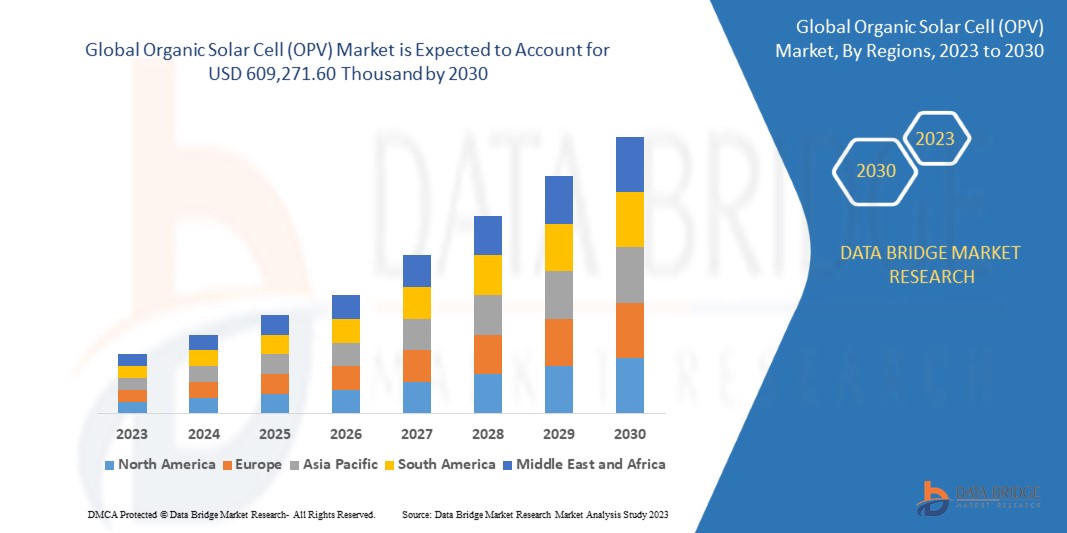
Organic Solar Cell (OPV) Market - Industry Outlook: Coverage, Market Potential, Evolution, Future Trends, and Ecosystem
Executive Summary Organic Solar Cell (OPV) Market :
Data Bridge Market Research analyses that the market is growing with a CAGR of 10.9% in the forecast period of 2023 to 2030 and is expected to reach USD 609,271.60 thousand by 2030.
The Organic Solar Cell (OPV) Market report gets familiar with the types of consumers, their views about the product, their buying intentions and their ideas for the step up of a product. This market research study helps in planning by providing accurate and state-of-the-art information about the consumer’s demands, preferences, attitudes and their changing tastes about the specific product. It estimates the market share and possible sales volume of a client company. Moreover, Organic Solar Cell (OPV) Market report discovers better and new methods to distribute the products to consumers and also recognizes the extent of marketing problems.

This Organic Solar Cell (OPV) Market research report also assists the manufacturer about planning of advertising and sales promotion efforts thereby making it more effective. It not only restrains the risks of ambiguity but also lends a hand in taking sound decisions. Furthermore, the report helps keep hold of reputation of the firm and its products. Whether it is about your product, customer, competitor or marketing strategy, market research analysis report helps drive your business in a right direction. To achieve competitive advantage and to thrive in the market, go for this market research report.
Discover the latest trends, growth opportunities, and strategic insights in our comprehensive Organic Solar Cell (OPV) Market report. Download Full Report: https://www.databridgemarketresearch.com/reports/global-organic-solar-cell-opv-market
Organic Solar Cell (OPV) Market Overview
Organic solar cells (OPV) continue to gain traction in the renewable energy sector due to their lightweight, flexibility, and potential for various applications. The market segmentation by type reflects the diverse options available to consumers, with single-layer organic solar cells offering portability and flexibility for applications like wearables, while multi-layer cells prioritize efficiency and stability for large-scale commercial use. This segmentation allows companies to target specific market needs and tailor their product offerings accordingly to meet the demands of different industries.
The application-based segmentation of the organic solar cell market further showcases the versatility of this technology across various sectors. The consumer electronics segment presents a lucrative opportunity for growth, driven by the rising demand for portable and flexible power sources in devices such as smartphones and wearables. Meanwhile, the automotive and aerospace industries are increasingly turning to organic solar cells to power electronic components and reduce carbon emissions, aligning with sustainability objectives. The emphasis on building-integrated photovoltaics (BIPV) highlights the potential for organic solar cells to be seamlessly integrated into structures, offering dual benefits of energy generation and aesthetic appeal.
When considering end-users, the market players need to cater to the unique requirements of residential, commercial, and industrial sectors. The residential segment's growth can be attributed to the increasing adoption of renewable energy solutions by homeowners seeking to reduce reliance on conventional power sources. In the commercial and industrial sectors, organic solar cells are viewed as an opportunity to achieve sustainability goals and cut down on energy expenses. By targeting these different end-user segments, companies can diversify their customer base and tap into emerging opportunities in the organic solar cell market.
Key market players such as Heliatek GmbH, Solarmer Energy, Inc., and AGC Inc. are at the forefront of driving innovation and development in organic solar cell technology. Their focus on research and development activities underscores the commitment to enhancing efficiency and durability, crucial factors for wider adoption of OPV solutions. Strategic partnerships and collaborations play a significant role in expanding product portfolios and market reach, enabling companies to capitalize on emerging trends and customer preferences. By investing in technology advancements and manufacturing processes, market players are positioning themselves for long-term success in the competitive organic solar cell market landscape.Organic solar cells (OPV) have emerged as a promising renewable energy technology with their lightweight and flexible nature, enabling diverse applications across various industries. The market segmentation based on type offers a tailored approach for companies to address specific needs. Single-layer organic solar cells are well-suited for portable devices and building-integrated photovoltaics, catering to the demand for flexibility and versatility. On the other hand, multi-layer organic solar cells provide higher efficiency and stability, making them ideal for commercial applications where performance is crucial. This segmentation strategy allows companies to align their product development efforts with the distinct requirements of different market segments, enhancing their competitiveness in the OPV market.